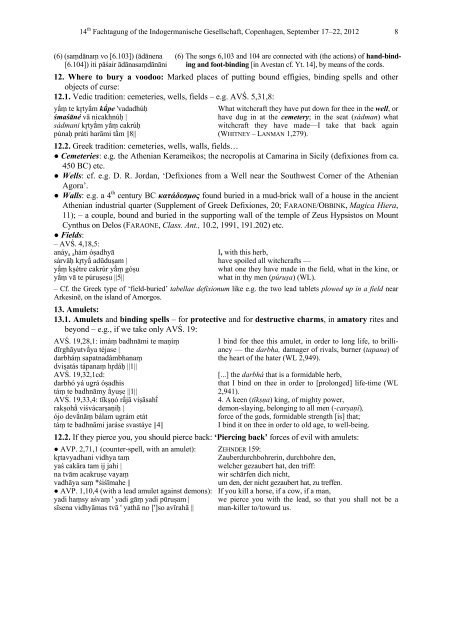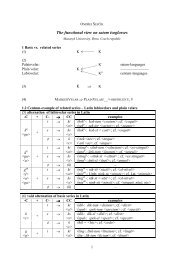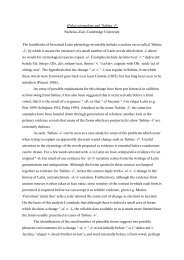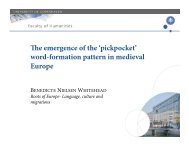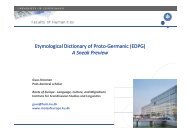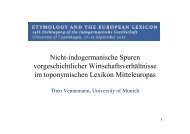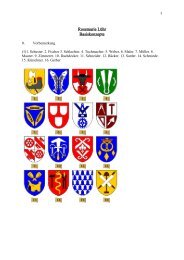Roots Deep in Heaven Indo-Iranian ritual concepts in a cross ...
Roots Deep in Heaven Indo-Iranian ritual concepts in a cross ...
Roots Deep in Heaven Indo-Iranian ritual concepts in a cross ...
Create successful ePaper yourself
Turn your PDF publications into a flip-book with our unique Google optimized e-Paper software.
14 th Fachtagung of the <strong>Indo</strong>germanische Gesellschaft, Copenhagen, September 17–22, 2012 8<br />
(6) (saṃdānaṃ vo [6.103]) (ādānena<br />
[6.104]) iti pāśair ādānasaṃdānāni<br />
(6) The songs 6,103 and 104 are connected with (the actions) of hand-b<strong>in</strong>d<strong>in</strong>g<br />
and foot-b<strong>in</strong>d<strong>in</strong>g [<strong>in</strong> Avestan cf. Yt. 14], by means of the cords.<br />
12. Where to bury a voodoo: Marked places of putt<strong>in</strong>g bound effigies, b<strong>in</strong>d<strong>in</strong>g spells and other<br />
objects of curse:<br />
12.1. Vedic tradition: cemeteries, wells, fields – e.g. AVŚ. 5,31,8:<br />
yā́ṃ te kr̥ tyā́m kū́ pe 'vadadhúḥ<br />
śmaśāné vā nicakhnúḥ |<br />
sádmani kr̥ tyā́m yā́ṃ cakrúḥ<br />
púnaḥ práti harāmi tā́m ||8||<br />
What witchcraft they have put down for thee <strong>in</strong> the well, or<br />
have dug <strong>in</strong> at the cemetery; <strong>in</strong> the seat (sádman) what<br />
witchcraft they have made—I take that back aga<strong>in</strong><br />
(WHITNEY – LANMAN 1,279).<br />
12.2. Greek tradition: cemeteries, wells, walls, fields…<br />
● Cemeteries: e.g. the Athenian Kerameikos; the necropolis at Camar<strong>in</strong>a <strong>in</strong> Sicily (defixiones from ca.<br />
450 BC) etc.<br />
● Wells: cf. e.g. D. R. Jordan, ‘Defixiones from a Well near the Southwest Corner of the Athenian<br />
Agora’.<br />
● Walls: e.g. a 4 th century BC κατάδεσμος found buried <strong>in</strong> a mud-brick wall of a house <strong>in</strong> the ancient<br />
Athenian <strong>in</strong>dustrial quarter (Supplement of Greek Defixiones, 20; FARAONE/OBBINK, Magica Hiera,<br />
11); – a couple, bound and buried <strong>in</strong> the support<strong>in</strong>g wall of the temple of Zeus Hypsistos on Mount<br />
Cynthus on Delos (FARAONE, Class. Ant., 10.2, 1991, 191.202) etc.<br />
● Fields:<br />
– AVŚ. 4,18,5:<br />
anáya ahám óṣadhyā<br />
sárvāḥ kr̥ tyā ́ adūduṣam |<br />
yā́ṃ kṣétre cakrúr yā́ṃ góṣu<br />
yā́ṃ vā te púruṣeṣu ||5||<br />
I, with this herb,<br />
have spoiled all witchcrafts —<br />
what one they have made <strong>in</strong> the field, what <strong>in</strong> the k<strong>in</strong>e, or<br />
what <strong>in</strong> thy men (púruṣa) (WL).<br />
– Cf. the Greek type of ‘field-buried’ tabellae defixionum like e.g. the two lead tablets plowed up <strong>in</strong> a field near<br />
Arkes<strong>in</strong>ē, on the island of Amorgos.<br />
13. Amulets:<br />
13.1. Amulets and b<strong>in</strong>d<strong>in</strong>g spells – for protective and for destructive charms, <strong>in</strong> amatory rites and<br />
beyond – e.g., if we take only AVŚ. 19:<br />
AVŚ. 19,28,1: imáṃ badhnāmi te maṇíṃ<br />
dīrghāyutvā́ya téjase |<br />
darbháṃ sapatnadámbhanaṃ<br />
I b<strong>in</strong>d for thee this amulet, <strong>in</strong> order to long life, to brilliancy<br />
— the darbha, damager of rivals, burner (tapana) of<br />
the heart of the hater (WL 2,949).<br />
́<br />
́<br />
dviṣatás tápanaṃ hr̥ dáḥ ||1||<br />
AVŚ. 19,32,1cd:<br />
[...] the darbhá that is a formidable herb,<br />
darbhó yá ugrá óṣadhis<br />
that I b<strong>in</strong>d on thee <strong>in</strong> order to [prolonged] life-time (WL<br />
táṃ te badhnāmy ā́yuṣe ||1||<br />
2,941).<br />
AVŚ. 19,33,4: tīkṣṇó rā́jā viṣāsahī<br />
4. A keen (tīkṣṇa) k<strong>in</strong>g, of mighty power,<br />
rakṣohā viśvácarṣaṇiḥ |<br />
demon-slay<strong>in</strong>g, belong<strong>in</strong>g to all men (-carṣaṇí),<br />
ójo devā́nāṃ bálam ugrám etát<br />
force of the gods, formidable strength [is] that;<br />
táṃ te badhnāmi jaráse svastáye ||4||<br />
I b<strong>in</strong>d it on thee <strong>in</strong> order to old age, to well-be<strong>in</strong>g.<br />
12.2. If they pierce you, you should pierce back: ‘Pierc<strong>in</strong>g back’ forces of evil with amulets:<br />
● AVP. 2,71,1 (counter-spell, with an amulet):<br />
kr̥ tavyadhani vidhya taṃ<br />
yaś cakāra tam ij jahi |<br />
na tvām acakruṣe vayaṃ<br />
vadhāya saṃ *śiśīmahe ||<br />
● AVP. 1,10,4 (with a lead amulet aga<strong>in</strong>st demons):<br />
yadi haṃsy aśvaṃ ' yadi gāṃ yadi pūruṣam |<br />
sīsena vidhyāmas tvā ' yathā no [']so avīrahā ||<br />
ZEHNDER 159:<br />
Zauberdurchbohrer<strong>in</strong>, durchbohre den,<br />
welcher gezaubert hat, den triff:<br />
wir schärfen dich nicht,<br />
um den, der nicht gezaubert hat, zu treffen.<br />
If you kill a horse, if a cow, if a man,<br />
we pierce you with the lead, so that you shall not be a<br />
man-killer to/toward us.


